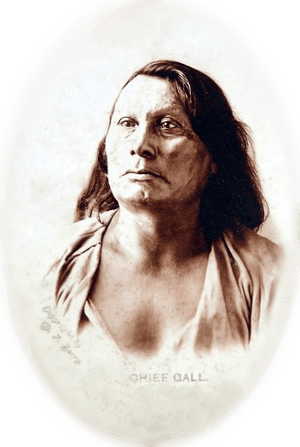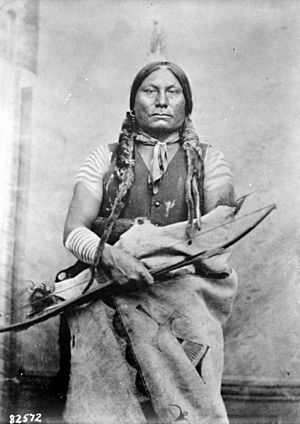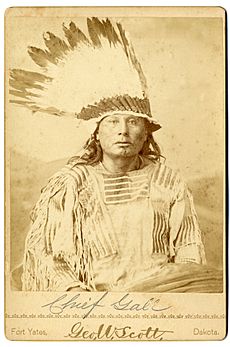Gall (Native American leader) facts for kids
Quick facts for kids
Gall
|
|
|---|---|
|
Phizí
|
|
 |
|
| Hunkpapa Lakota battle leader | |
| Personal details | |
| Born | c. 1840 South Dakota |
| Died | December 5, 1894 (aged 54) Wakpala, South Dakota |
| Resting place | Wakpala, South Dakota |
| Military service | |
| Battles/wars | Battle of the Little Bighorn |
Gall (born around 1840 – died December 5, 1894) was a very important military leader of the Hunkpapa Lakota people. His Lakota name was Phizí. He played a key role in the famous Battle of the Little Bighorn. After the wars, he lived in Canada for four years with Sitting Bull's group. In 1881, he returned to the United States and lived on the Standing Rock Indian Reservation. Later in his life, Gall encouraged his people to adapt to reservation life. He even became a judge for his tribe.
Contents
Gall's Early Life
Gall was born in what is now South Dakota around 1840. He became an orphan at a young age. It is said he got his name, Gall, after eating the gall (a bitter part) of an animal killed by a neighbor.
By his late teens, Gall was already a skilled warrior. He became a war chief in his twenties. As a Lakota war leader, Gall fought against the United States moving onto tribal lands. He fought alongside Sitting Bull in several battles, including the well-known Battle of the Little Bighorn in 1876.
Gall at the Battle of the Little Bighorn
Since the early 1980s, experts have studied the Battle of the Little Bighorn more closely. They looked at what Native Americans who were there said and listened to tribal stories. This new information shows that Gall made several smart decisions during the battle. These decisions helped the Sioux and Cheyenne tribes defeat the soldiers led by General Custer.
Major Marcus Reno's first attack was on the southeast side of the Native American village. During this attack, Gall's two wives and several of his children were killed. Gall later said, "My heart was very bad that day."
At the start of the battle, the Lakota and Cheyenne pushed back Reno's soldiers. Gall was one of the few Native Americans who thought Custer might attack from two different directions. He knew it was important to find the other part of Custer's army.
Gall crossed the river and rode to the northeast. There, he saw Custer's main scout, Mitch Bouyer, returning to Custer. After finding Custer's main group of soldiers, Gall realized they probably planned to cross the river and enter the northern part of the village.
Riding back, Gall told the Sioux and Cheyenne warriors what he had seen. With Crazy Horse, he led forces north across the river. They pushed two of Custer's companies (Company E and F) north. This forced three of Custer's companies to fight a defensive battle.
Within minutes, Gall and his forces took a position northeast of Finley Ridge. They fired heavily down on Companies C, I, and L. When Crazy Horse attacked Company L and Company I, Company L likely started to move back. Companies C and L tried to change their positions. This probably looked like a panicked retreat to Gall and his forces.
Seeing that the soldiers no longer had the strong firing power to hold the Native Americans back, Gall and his men attacked from the east. Other Native Americans attacked the cut-off parts of Company C from both the east and the south. They quickly defeated Companies C and L. Survivors and some of Company I fled towards Custer and his men. A few soldiers also ran south toward the river. White stone markers still stand where these soldiers fell.
Soon, the Native Americans finished off Custer and his remaining soldiers. The last 28 survivors tried to run south to the river. They were trapped in a narrow canyon called "Deep Ravine." After defeating them, the Native Americans had won the battle. They had completely wiped out Custer's five companies.
In later years, Gall talked about his part in the battle. He had thought the soldiers ran out of ammunition. However, the soldiers may have also run away because they lost their will to fight. Many men simply ran, even leaving loaded rifles behind. The Native American warriors picked up these weapons and fired them to scare away the soldiers' horses. This took away the soldiers' ability to move quickly. The warriors attacking Greasy Grass Ridge mostly came on foot. Gall kept firing from the northeast.
Gall's Later Life
In late 1876, many Hunkpapa groups crossed into Canada. They struggled to survive there for several years. Gall eventually disagreed with Sitting Bull. He brought his group back to the United States and surrendered on January 3, 1881. On May 26, 1881, he and his followers were taken by boat to the Standing Rock Indian Reservation. A count of the Lakota at Standing Rock in 1881 showed Gall had a group of 52 families, totaling 230 people.
Gall became a farmer and encouraged his people to adapt to life on the reservation. He also became a Christian and took the name Abraham. He served as a judge on the reservation's Court of Indian Affairs. He became friends with the Indian Agent, James McLaughlin. The 1885 reservation count listed Gall as responsible for 22 lodges (homes) and 114 people.
Gall later disagreed with Sitting Bull, who became involved with the Ghost Dance movement. Sitting Bull was killed by a tribal policeman in 1890 during a difficult situation.
Gall's Death
Gall lived on the Standing Rock Agency until he died at his home on December 5, 1894. He is buried in Saint Elizabeth Episcopal Cemetery in Wakpala, South Dakota. In 1991, his remains were checked because a museum claimed to have his skull. However, his remains were found to be complete.
See also
 In Spanish: Pizi para niños
In Spanish: Pizi para niños



